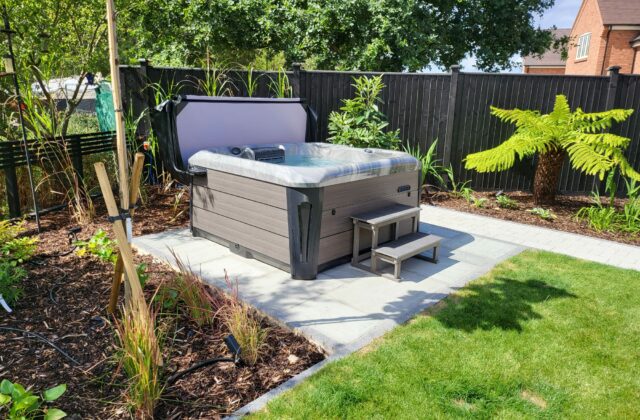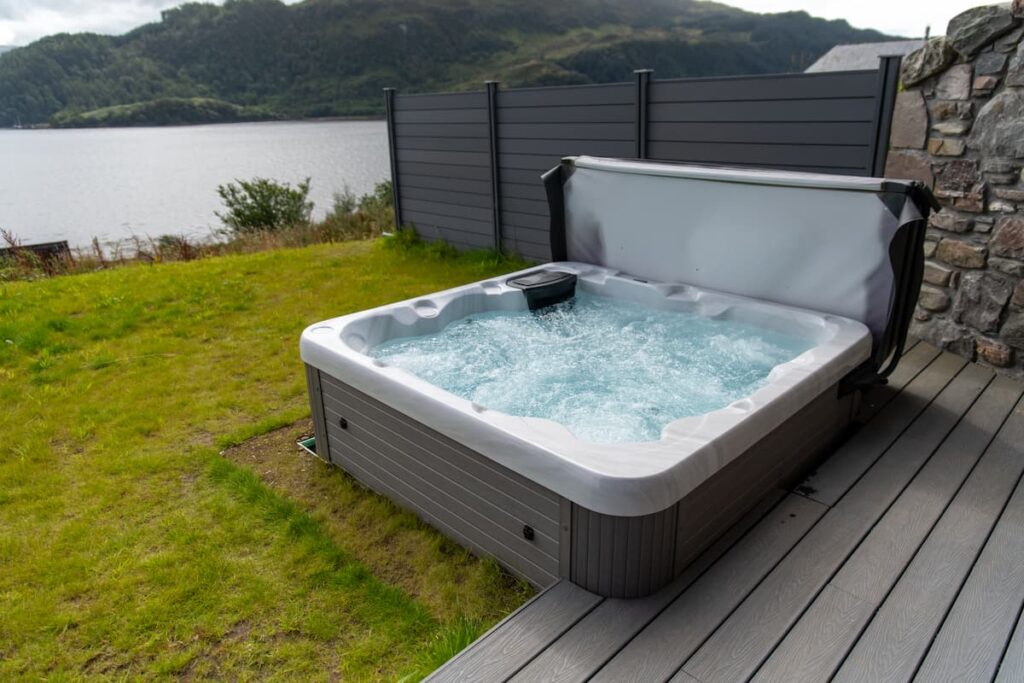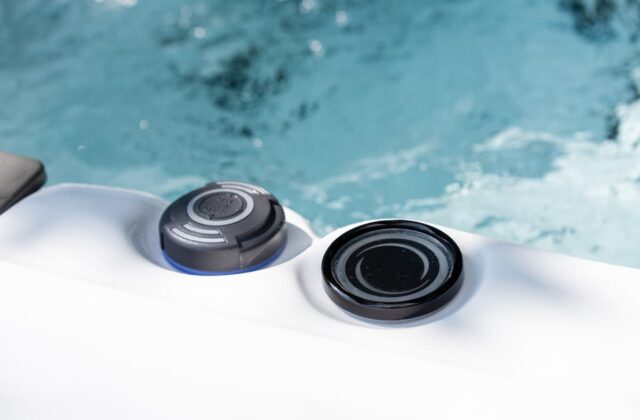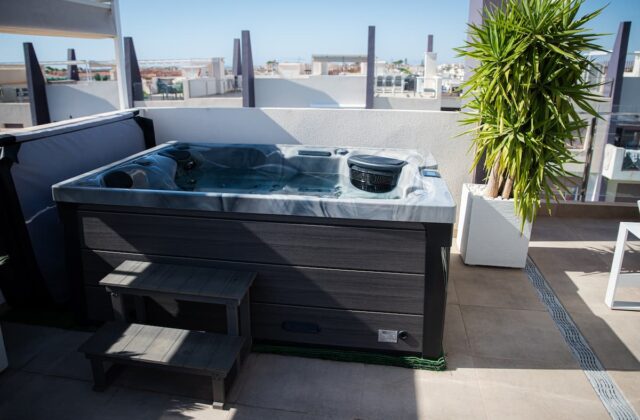One of the biggest questions that potential hot tub owners ask is “how long does a hot tub take to heat up?”. It makes sense because even excluding the first time you fill your hot tub, you should be emptying and refilling your hot tub 3–4 times a year, if you’re following a recommended cleaning schedule.
This article will cover how long a hot tub takes to heat up, the factors that impact how long it takes, and a few tips you can implement which can help to accelerate the process.
How Long Does a Hot Tub Take To Heat Up?
A hot tub can take up to 12 hours to fully heat up the water to the ideal temperature. However, there are several factors that will impact how long this process takes, such as the size of the hot tub, the outside temperature and the quality of your hot tub’s insulation.
What Affects How Long a Hot Tub Takes To Heat Up?
The Size of Your Hot Tub
This seems obvious, but a bigger hot tub requires more water, and therefore will take longer to get to temperature than a smaller hot tub. When it comes to looking at hot tubs to buy, you should consider the size of the hot tub vs how many people will be mostly using it. You will waste a lot of time and money on heating up an 8-person hot tub, if only 3 of you will be using it regularly.
If the hot tub doesn’t mention how many people it fits, you can work it out based on its water capacity. A rough guide is around 250 litres of water per person. So, a 1000 litre hot tub is roughly made for 4 people.
The Power of Your Hot Tub’s Heater
Typically, your hot tub should have an appropriately powerful heater, based on the size of the hot tub. Having a heater that isn’t very powerful, for a large hot tub, will mean that it will take significantly longer to get the water to the ideal temperature of 36-38 degrees Celsius.
Alternatively, while having a powerful heater in a smaller hot tub will reduce how long it takes to heat up, it will also increase the cost of your energy bills too. It’s worth considering that, on average, you only need to completely refill your hot tub 3–4 times a year.
As long as you plan your hot tub soaks and hot tub refills so that you’re not waiting around for it to heat up, opting for an overly powerful heater doesn’t make too much of a difference.
The Quality of Your Hot Tub’s Insulation
Having a hot tub with good quality insulation throughout will significantly increase the amount of heat retained within the tub and water. Which means when it comes to heating up your hot tub, less heat is lost, and therefore it won’t take as long.
Typically, higher quality insulation hot tubs are more expensive. However, it’s worth saving up for a bit longer and increasing your budget to get a hot tub with good insulation. While cheaper hot tubs might save you money up front, the extra money you’ll spend on energy bills will eventually overtake that initial savings amount. Think of spending a bit more money on a well-insulated hot tub as a long-term investment for saving money.
Our premium range and deluxe range hot tubs utilise our award-winning insulation, Platinum Premium Shield. Which uses 5 different types of insulation to minimise heat loss and save you money on your energy-bills.
The Quality of Your Hot Tub’s Cover
Having a high-quality cover for your hot tub can make a huge difference to how energy efficient your hot tub is, and therefore how long it takes for it to heat up. Up to 60% of a hot tub’s heat loss is from the surface of the water. This makes sense if you think about it, as it has the largest amount of surface area exposed to the air.
A high-quality cover should be at least 4 inches thick and made from a high-density foam such as polyurethane, which will act as a thick layer of insulation. In addition to this, the cover should use a continuous heat seal that is airtight, which helps to keep hot air in and cold air out. Finally, your cover should be tapered at the edges, so that rain and snow can run off it.
The Outside Temperature
A big variable in how long it takes for your hot tub to heat up is the outside, ambient temperature. This might seem obvious, but a hot tub in a colder environment will take longer to come up to temperature than a hot tub in a hot environment.
Elements like how exposed your hot tub is to wind and rain will also impact how long your hot tub takes to heat up. Having a hot tub with high-quality insulation and a good cover, as mentioned above, will help to mitigate some of the impact the external conditions have.
The Water’s Starting Temperature
The starting temperature of the water will also determine how long it takes for a hot tub to heat up to the right temperature. However, this doesn’t mean you should be running back and forth from the kitchen with a boiling kettle.
Not only will it have minimal impact because of the sheer capacity difference, but also doing so could potentially damage your hot tub’s shell. Hot tubs aren’t made for incredibly hot temperatures, as typically the water in them doesn’t exceed 40 degrees Celsius.
You’re better off saving time and energy on kettle runs, and letting your hot tub do its job.
The Condition of Your Hot Tub
The condition that your hot tub is in will play a part in how long it takes for it to heat up. In particular, the condition of the heater will make a big difference. A worn out heater will be much less efficient at heating water, which is why it’s important to have your hot tub regularly serviced by a professional.
This means the heating elements, filters and jets will stay in good condition and remain efficient. We recommend getting your hot tub serviced by a professional at least once a year. It’s not just the mechanical elements that need to be in good condition, cracks or damage to your cover can also contribute to a hot tub’s heat loss increasing. It’s worth checking the cover periodically to make sure it is still in good condition.
Tips To Improve How Long It Takes For Your Hot Tub to Heat Up
While the points mentioned above will impact how long it takes for your hot tub to heat up, there are some tips and tricks you can implement to help speed up the process.
Leave Your Hot Tub On
Although it sounds counterintuitive, your hot tub is actually much more efficient energy-wise if you leave it on and let it maintain the temperature. This is because water takes significantly more energy to heat up from cold, than it does to keep it at a warm temperature.
Other than for quarterly drains, or perhaps if you retire the hot tub for winter when you’re not using it as much, it’s much better to leave your hot tub on and full. This means you’ll only have a lengthy wait for it to heat up a few times a year!
Utilise Windbreaks & Shelter
To help combat the effects of wind, rain and the colder ambient temperatures, you can utilise windbreaks to help shelter your hot tub, therefore keeping it warmer.
Windbreaks
For windbreaks, you can either position your hot tub in a natural alcove if you have one, or you can install windbreaks yourself. One way to do this is by planting hedges or shrubs which can act as a natural barrier against the wind. Another option is to use wooden panels such as trellises to create a partial enclosure around the hot tub.
Not only will windbreaks help to keep the hot tub warmer, but they’ll also provide the added benefit of more privacy, which can help to make your overall hot tub experience more enjoyable.
Sheltering
A popular option for people who have the space is to cover their hot tub area with a roof. Often these can be made from wood and other materials, and can match the aesthetic of using wooden trellises around your hot tub.
Not only will a roof keep the snow and rain off your hot tub, but will also contribute to reducing the amount of wind too.
Use The Jets When Heating Your Hot Tub
This topic can sometimes cause a bit of debate, as using the jets in a hot tub introduces air into the water, which cools it down slightly. This means the heating element needs to work harder to maintain the temperature.
However, periodically using the jets when initially heating up your hot tub can help to circulate the water, making sure there are no cold spots. Using the jets can also help to reduce any cold pockets formed in the pipes. When doing this, you don’t want to leave the jets on constantly, but instead turn them on in short bursts once the water has started to warm up.
Conclusion
The time it takes for a hot tub to heat up is around 12 hours, at a rate of 1-2 degrees Celsius per hour. There are many factors, such as the size of your hot tub, outside temperature and the quality of your hot tub’s insulation which can affect this.
You can implement additional elements like windbreaks to help prevent the wind from further impacting the hot tub’s temperature. Additionally, maintaining your hot tub and keeping it in good condition will help to keep the energy efficiency higher.
Looking For A High-Quality Hot Tub?
Here at Platinum Spas, we pride ourselves on the quality of our hot tubs. We offer a range of sizes, from 3-person hot tubs, to 8-person hot tubs. All of our hot tubs boast fantastic quality and craftsmanship, helping to make your hot tub experience that much more enjoyable and relaxing.
Get in touch with one of our team members today, and we’ll help to find you the perfect hot tub that matches your needs.
Frequently Asked Questions
How Long Does It Take To Heat Up a Hot Tub?A hot tub can take up to 12 hours to heat up after it has been filled with fresh water. The temperature will rise by about 1–2 degrees Celsius per hour, until it reaches the desired temperature. Factors like the outside temperature, the level of insulation your hot tub has, and the size of your hot tub will determine how long it will take.
Does a Hot Tub Heat Faster With a Cover On?A hot tub will heat up significantly faster with a good quality cover on. Up to 60% of a hot tub’s heat loss is through the surface of the water, so covering that up with an airtight, well insulated cover will help to mitigate this. The more heat kept in the hot tub at any one time, the quicker it will heat up.
Jamie Smith is the general sales manager at Platinum Spas, and has years of professional expertise in the hot tub industry. From Business Development to Sales, Jamie has helped grow our business into a global powerhouse, working with our partners and developing our offering as we strive to be market leaders.
Latest posts by Jamie Smith
(see all)


